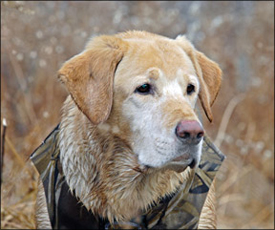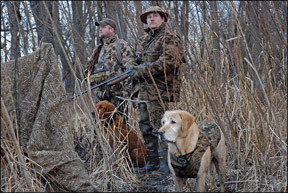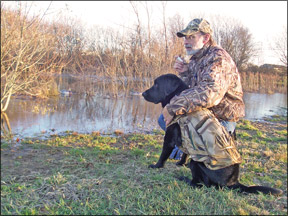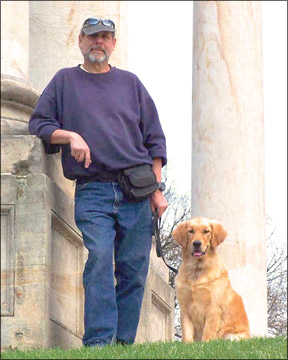Retrievers, yes. Pointers, yes. Setters, yes. Spaniels, yes. Curs . . . wait. Curs? Wait a minute. Feists? Plott Hounds? Not so fast! What’s going on here? I thought we were talking “hunting dogs.”
Depending on who you talk to, “hunting dog” means very different things. The only thing in common may very well be that the human end of the leash historically toted a gun in pursuit of some type of “game.” The game in question was not after-dinner parlor entertainment, but the entree on your dinner table. That might be pheasant, duck, or squirrel. Through hundreds of years, the real-life pursuit of food for one’s family has morphed into a competitive sport for people who rely upon Safeway to meet their nutritional needs.

288
The diversity of breeds and types of competition is simply mind-boggling, with separate sanctioning organizations, each with its own standards of competition for retrievers, pointers, setters, etc., as well as for coon hounds, curs, and feists. There are many different kinds of hunting (bird dogs, treeing dogs, scent hounds, etc.) and each type of hunting competition has its own unique rules and regulations – and owners who are hunting for ribbons for their walls and bragging rights among friends and competitors.
Hunting is also another sport in which, historically, dogs are usually trained with at least a certain amount of traditional, force-based training methods. It is common practice in all the hunting disciplines to use shock collars and other compulsive training techniques, even on very young puppies.
However, there are more and more people in the hunt and field sports who are breaking from tradition and using positive reinforcement in their hunting dog training. I found two Yahoo discussion lists dedicated to positive gun dog training, and met some wonderful proponents of this new approach. You are in for a treat. Meet three pioneers from a small but growing band of people whose quest for ribbons has not trumped their love of their dogs nor their belief in the power of positive reinforcement training.
Inga From: Bringing clickers and gun dogs together
Inga From, CPDT-KA, is a professional trainer and the behavior and training coordinator for the Minnesota Valley Humane Society. In her day job she manages shelter volunteers, runs the shelter’s dog training program, and offers pet education to the public and to shelter staff and volunteers. In 2008 she was the recipient of the Association of Pet Dog Trainers’ Premier Shelter Staff Award.

288
In addition to her day job, she runs a private training business that offers a variety of services and classes, including gun dog training. She is an ex-game warden, and she and her husband hunt waterfowl and upland birds with their yellow Lab (Loki) and Springer Spaniel (Ammo).
From grew up with dogs. Her mother was a groomer and the family had Springers. From started 4-H in grade school and dog training became her favorite hobby. She showed in county, state, and regional fairs in obedience and conformation all through high school. Her father taught her hunting ethics: “I hunt only what I will eat and I will not be wasteful with game or disrespectful to habitat, land owners, or animals.”
From learned how to work with gun dogs from friends during high school. Later, she joined a program called Women in the Outdoors, a division of the National Wild Turkey Federation. All the training was traditional. Then she met her husband Mike, who also had a hunting dog (Loki), but was not comfortable with some conventional, force-based training.
“He listened to the dog and if Loki seemed unhappy, he would change things to fit the situation. He worked Loki in a non-traditional way and was not even aware of it. Loki has been working years in the field and is a very successful retriever without being taught a force fetch. Loki has hunted season after season without the use of an electronic collar. I figured if my husband can do this as a dog owner, why can’t I, a professional dog trainer?”
From’s crusade was about to begin.
She started by clicker training her dog, Ammo, for pet manners. “I knew that he was going to be trained with a clicker for manners so why would I switch training methods on him just because he was going to hunt? I stayed the course with him and his clicker, and he has never known any other way. Ammo has also enjoyed many seasons in the field hunting with Loki, my husband, and me, and he does just fine; we rarely lose any birds.”
From attended a seminar on the East Coast by Jim Barry, and she looked into the United Kingdom Gundog Club, which she heard might fit her philosophy about training and hunting. “I teach positive training and I use clickers. I use the LIMA (least invasive, minimally aversive) principle in all my teaching. Because of the training methods I choose to use, the U.K. gun dog award fits the best for this type of training. All of the current U.S. organizations that test gun dogs are dominated by traditional force-based training.”
From’s clients are supportive. They have not felt welcome at many trials because they don’t use traditional methods. Some have even been told they can’t use clickers. But the U.K. Gundog Club puts a heavy emphasis on obedience training before training for a sport. Also, electronic shock collars are not embraced by British trainers generally, and it is believed that the use of shock collars will be outlawed in the U.K. With such an emphasis on basic training first, From feels that clicker training will have a much better chance in the U.K. program.
From sees a trend from the people who attend her seminars. Instead of being hunters themselves, they have a family dog that they are interested in training for what he or she was bred to do.
“I hope to pioneer this new field of family dog field training; it’s increasing in demand, especially in my state of Minnesota. I had people come to my last seminar from not only Minnesota, but also Iowa, Wisconsin, and Illinois. I am a hunter myself, but train my dogs in a non-traditional method for the gun dog world. People like me are out there, and they want something more than what is now available in the gun dog world.
“It’s not that traditional training does not work with gun dogs; it does. It’s that there are other alternatives that will work just as well in the long run. Why not blaze a new trail and see if anyone will follow? I cannot wait for the day when this type of training is mainstream and there is an organization in the U.S. that supports and expands it. Maybe I’ll have to start my own club for positive-trained gun dogs! I am working on that now, slowly, step by step with Positive Gun Dogs of Minnesota.”
Jim Barry: Writing guides for others
Jim Barry, CPDT-KA, CDBC, is the author of The Ethical Dog Trainer and co-author of Positive Gun Dogs: Clicker Training for Sporting Breeds. In addition to running a private dog training business (Reston Dog Training, in Reston, Virginia), Barry is a senior fellow at the Center for International Development and Conflict Management of the University of Maryland, where he conducts research on international issues and teaches programs in negotiation and crisis leadership.

288
Barry is one of only two people in the U.S. to have been authorized to give awards for field tests sponsored by the U.K. Gundog Club. His entry into the gun dog world came about after he got his black Labrador, Toby. Barry and his wife Vicki planned on doing therapy dog work with their new pup, purchased from a breeder of show/obedience lines. That quickly changed as Toby demonstrated his love of water and a strong retrieving instinct. “I started working on a formal retrieve and one thing led to another,” said Barry.
At the time, Barry was an intern with Carole Peeler, CDBC, CPDT-KA in Falls Church, Virginia. Barry completed all of Peeler’s clicker training classes, and then started looking for a trainer who used clicker training for field work. “I was disappointed to discover that no one in my area taught field work with positive methods,” he says. He joined the Positive Gun Dogs discussion list on Yahoo.com, started reading everything he could get his hands on, talked to experienced gun dog trainers, and then tried applying clicker training to it all. As a result, Toby now has a Working Certificate from the Labrador Retriever Club of the United States. “In a sense, Toby and I were the ‘lab rats’ for this new method of gun dog training.”
Barry met his co-authors on the Yahoo list, and together, they decided the world needed a book about clicker training for gun dogs. Their resulting book was published in 2007. “It seemed like every time a new person joined the Yahoo list, he or she asked, ‘Where’s the book on positive field training?’ There were none at the time, although Helen Phillips in the U.K. later wrote Clicker Gundogs, so we decided to write one. Sue Smith took the lead on the learning theory and basic training chapters, I wrote the retrieving sections, and Mary Emmen did the upland hunting portions.”
The mere thought that dogs could be trained without shock collars, much less with a clicker, was to say the least, novel. And unproven. To have a book published on the subject gave a small, but growing, community of positive trainers the boost they needed. However, Barry is circumspect about the growth of positive training in the sport.
“All dog sports are challenging, but in gun dog training there are three specific issues that stand out. The first is that the tasks are inherently very demanding, both physically and mentally. They may involve working in difficult terrain and nasty weather for long periods of time, searching for game that is hidden in deep cover. Dogs may have to swim long distances, climb banks, and jump fences. And all of this must be done while being attentive to the handler and the goals.
“The second challenge is that much of the work is done at great distance. In higher-level retriever tests, for examples, multiple retrieves at distances of hundreds of yards are not uncommon. Finally, in field work, there are many opportunities for dogs to engage in inherently rewarding behaviors, such as chasing game or following scents that do not coincide with the handler’s desires.
“Because of these complexities, we had to think creatively not only about basic training methods, but also how to organize training and the sequence in which various skills are introduced. We know that you can train a reliable hunting companion without using an electric collar. I’ve done it and so have many others. We also know that you can train pointing dogs to Master Hunter level and, with patience and dedication, retrievers to at least Senior Hunter level.
“Finally, thousands of high-performing gun dogs have been trained in the U.K. and other European countries where e-collars are either banned or rarely used. What we don’t know, and may not know for some time, is whether dogs can be trained to the highest levels in U.S. retriever trials using positive reinforcement exclusively. As noted above, these trials are exceedingly difficult and require training dogs to do things that are in some ways counter-intuitive, such as holding straight lines rather than taking routes that require less energy. Several dedicated people are working on this goal, and time will tell.”
Barry agrees with Inga From that the U.K. Gundog Club is a good fit for training the family dog to be a gun dog. He, too, believes that the emphasis on steadiness and reliability before training hunting skills is a good fit for positive training. This is because training at a skill level that is too advanced for the dog (e.g., long-distance retrieves) often prompts trainers to use aversive methods such as the shock collar.
Barry is both hopeful and realistic about the trend in positive gun dog training. “I think it’s largely a reflection of the general interest in more humane training. However, the growth is slow because there is little overlap between people who hunt and people who are interested in operant conditioning! But the Positive Gun Dogs (Yahoo) list now has some 800 members, up from 300 when I joined, so that’s progress!”
That said, Barry is not overly optimistic about positive training becoming mainstream any time soon. “I believe this is beginning to occur for pointing and versatile breeds. In the U.S. retriever trial world, I believe it will take a very long time. This is both because of the demands of the sport and because there is currently a strongly held belief, fostered by professional field trainers and e-collar manufacturers, that existing training systems are highly effective. Having said that, I also believe that positive training has begun to catch on for recreational hunters and people who want enrichment activities for their family dogs. This is where I see the greatest opportunity for acceptance and growth.”

288
Lindsay Ridgeway: Proving it can be done
Lindsay Ridgeway, of Laytonsville, Maryland, is a software designer by day, but some of his proudest moments have come from designing dog training plans and seeing his dogs blossom as a result. Ridgeway is an active proponent of positive gun dog training and is considered by some to be the poster child of the movement toward positive training in the sport. He and his Golden Retrievers, Lumi and Laddie, achieved AKC’s Junior Hunter (JH) and Senior Hunter (SH) titles, with some first-place finishes along the way. They also have been awarded the highest field title (Working Certificate Excellent) from the Golden Retriever Club of America – all without using aversives in training.
It could be argued that Ridgeway’s influence in the sport is a result of two of his hobbies. In the past, he participated in endurance sports, running 14 marathons, and thus has a keen understanding of the mental and physical stamina required to go the distance. His other hobby, which he applies skillfully, is writing about dog training! More than likely, it will be the combination of stamina and writing that will help him pursue personal training goals as well as getting the word out about positive gun dog training.
In 2003, Ridgeway got his first Golden Retriever, Lumi. He discovered clicker training after trying puppy training techniques that he found scary for his pup and detrimental to his relationship with her. He started the DogTrek (Yahoo) list in 2005 to share his experiences.
He competed with Lumi in agility, but retired her from that sport when arthritis made competing and training too difficult. It was then that he began the search for alternatives to conventional gun dog training techniques. In 2007 he brought home Laddie. Three years later he had JH, SH, and GRCA titles on both dogs. How did he do it?
“Like nearly all clicker trainers who come to the sport, I initially found books on traditional field training useless except for their interesting anecdotes, because the stated goal of every exercise seemed to be to teach the dog to accept force, and that was simply not my goal. I reached the same conclusion that clicker trainers attempting field work almost invariably reach: whole new training methods would be needed.”
Ridgeway spent hours reading books and participating in online discussion groups and met two traditional trainers who were willing to share their methods and love of the sport.
“They took me under their wings. They helped me understand that those traditional drills were exactly what my dogs needed; I just needed to subtract the coercion element. As they helped me to understand the procedures, I saw that in most cases, in addition to training the dog to accept force, the drills also taught the dog vital concepts of field work.
“Generations of trainers had discovered not only what concepts the field dog needs to learn, but equally important, in what order those concepts need to be learned. I simply had to train those concepts in new ways, while allowing my dogs to go through the same crucial sequence of learning. The missteps my mentors helped me and my dogs to avoid became as crucial as finding the correct stepping stones to follow,” says Ridgeway.
Key to his success, Ridgeway believes, was his ability to put aside philosophical differences and to learn from those experienced traditional trainers. “Several times a week, I’d watch expert trainers and their dogs perform the skills that Lumi and Laddie were also learning to perform. Yes, I was ‘different’ because of my strange refusal to use ‘corrections,’ and as in any group some of the relationships were smoother than others. But real friendships were forged and became the key to continued progress. Without them, my dogs’ field careers would have ended before they started.”
When asked how he responds to people who say that dogs in this sport simply can’t be trained without shock collars, Ridgeway’s response reflects both his pragmatism and optimism. “I think that it is far more difficult to train without aversive methods in sports that are closely bound to the dog’s breeding traits – sports such as herding, police-dog work, and field work. For the trainers who first attempt such training, progress may be significantly slower than for traditional trainers following a well-established program, and it may even be that generations from now, such methods will still be slower than traditional methods.
“In addition, my dogs have only attained their Senior Hunter titles so far, and it remains to be seen whether more advanced titles are even possible for [dogs trained with positives]. So my answer is: Yes, training without an e-collar makes participation in the sport more challenging than training with one. But Lumi and Laddie, dogs with very different breeding and personalities, have shown that it is possible to train a retriever to advanced titles using [positive] methods.”
Ridgeway has every intention of continuing to train Laddie for other advanced titles. He has a list of training goals and is in the process of designing training plans to attain them. “Unless and until I, or someone else, shows that positive training can accomplish the same goals as traditional tools and methods without significantly more time and effort, I see little incentive for most serious amateurs or professionals to switch to [positive] methods unless they have personal reasons for doing so. On the other hand, the traditional tools and methods for training a retriever have become dramatically more humane over the years, and I suspect that trend may continue. Whether the efforts and achievements of positive trainers, who comprise an infinitesimal fraction of the sport, will have any effect on that trend, I consider doubtful. I think it’s just that as time goes by, traditional trainers discover new tools and methods that are more effective and also happen to be more humane.”
But that doesn’t mean that he isn’t going to do his best to prove that it can be done.
Terry Long, CPDT-KA, is a writer, agility instructor, and behavior counselor in Long Beach, CA. She lives with four dogs and a cat and is addicted to agility and animal behavior. See page 24 for contact info.





